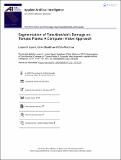| dc.contributor.author | Loyani, Loyani | |
| dc.contributor.author | Bradshaw, Karen | |
| dc.contributor.author | Machuve, Dina | |
| dc.date.accessioned | 2022-09-16T08:32:58Z | |
| dc.date.available | 2022-09-16T08:32:58Z | |
| dc.date.issued | 2021-09-06 | |
| dc.identifier.uri | https://doi.org/10.1080/08839514.2021.1972254 | |
| dc.identifier.uri | https://dspace.nm-aist.ac.tz/handle/20.500.12479/1637 | |
| dc.description | This research article was published by Taylor & Francis Group, 2021 | en_US |
| dc.description.abstract | Tuta absoluta is a major threat to tomato production, causing losses ranging from 80% to 100% when not properly managed. Early detection of T. absoluta’s effects on tomato plants is important in controlling and preventing severe pest damage on tomatoes. In this study, we propose semantic and instance segmentation models based on U-Net and Mask RCNN, deep Convolutional Neural Networks (CNN) to segment the effects of T. absoluta on tomato leaf images at pixel level using field data. The results show that Mask RCNN achieved a mean Average Precision of 85.67%, while the U-Net model achieved an Intersection over Union of 78.60% and Dice coefficient of 82.86%. Both models can precisely generate segmentations indicating the exact spots/areas infested by T. absoluta in tomato leaves. The model will help farmers and extension officers make informed decisions to improve tomato productivity and rescue farmers from annual losses. | en_US |
| dc.language.iso | en | en_US |
| dc.publisher | Taylor & Francis Group | en_US |
| dc.subject | Research Subject Categories::TECHNOLOGY | en_US |
| dc.title | Segmentation of Tuta Absoluta’s Damage on Tomato Plants: A Computer Vision Approach | en_US |
| dc.type | Article | en_US |

